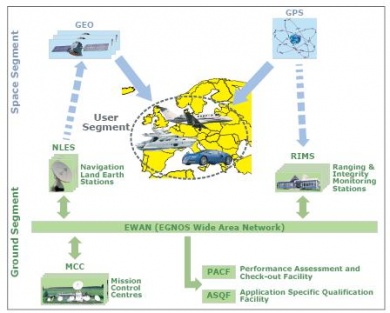If you wish to contribute or participate in the discussions about articles you are invited to contact the Editor
EGNOS Architecture: Difference between revisions
Jon.Caudepon (talk | contribs) |
Jon.Caudepon (talk | contribs) |
||
| Line 45: | Line 45: | ||
|- | |- | ||
|style="background-color:#FFFFFF;" ; align="center" |'''INMARSAT IOR-W''' || style="background-color:#FFFFFF;" ; align="center" | 126 || style="background-color:#FFFFFF;" ; align="center" |39 || style="background-color:#FFFFFF;" ; align="center" |25E | |style="background-color:#FFFFFF;" ; align="center" |'''INMARSAT IOR-W''' || style="background-color:#FFFFFF;" ; align="center" | 126 || style="background-color:#FFFFFF;" ; align="center" |39 || style="background-color:#FFFFFF;" ; align="center" |25E | ||
|} | |} | ||
Revision as of 16:27, 3 May 2011
| EGNOS | |
|---|---|
| Title | EGNOS Architecture |
| Author(s) | GMV. |
| Level | Basic |
| Year of Publication | 2011 |
The goal of EGNOS (European Geostationary Navigation Overlay Service) is to augment the [GPS Introduction|GPS]] in order to improve the navigation performances in terms of accuracy and integrity (with the required levels of availability and continuity of service) over the European Civil Aviation Conference (ECAC) Region and to be expandable over neighbouring regions.
These augmentations are obtained by providing a GPS-like Geostationary Ranging service (R-GEO), by broadcasting precise Wide Area Differential corrections to correct for GPS, GLONASS and GEO orbit and clock errors and also to correct the ionospheric delays affecting the signal paths to the users. The complex message broadcast by EGNOS GEOs also include Integrity data which allow to bound the remaining errors with a high level of confidence. EGNOS has deployed its Advanced Operational Capability (AOC) using two existing INMARSAT-III navigation transponders (AOR-E and IOR-W) plus a navigation transponder on board of Artemis satellite.[1]
The EGNOS architecture is very complex and highly redundant. It is composed by 47 elements deployed onto 41 sites in 22 Countries. EGNOS has been designed to meet the international SBAS standards and performs the following tasks:
- Collect GPS/GLONASS/GEO signals and data.
- Estimate the integrity data and WAD corrections for the service area.
- Transmit to the users, via the GEO satellites, a GPS-like signal, augmented with integrity and correction messages.
- Verify the correctness of these integrity and correction messages.
Architecture Overview
The EGNOS system is directly decomposed in its four segments, a Ground Segment, a Space Segment, a User segment and a Support Segment:[2]
- The Ground Segment is the real-time part of EGNOS. It computes precise differential corrections as well as the GEO ranging and makes all these information available to users through a broadcast by the Space Segment.
- The Space segment, using three GEO satellites, provides redundant data transmission channel to broadcast toward EGNOS users messages containing differential corrections with the associated integrity information. The GEO satellites additionally provide GPS-like ranging signal that is permanently steered and synchronised by the ground segment.
- The User Segment is made of EGNOS receivers that enable EGNOS users to accurately compute their position.
- The Support segment contains off-line facilities listed hereafter:
- PACF: Performance Assessment and Check-out Facility, provides support to EGNOS management in such area as performances analysis, troubleshooting, operational procedures as well as upgrade specification and validation, support to maintenance.
- ASQF: Application specific qualification facility provides civil aviation and aeronautical certification authorities with the tools to qualify validate and certify the different EGNOS applications.
- DVP: Development & Verification platform is used to validate and verify EGNOS requirements during the design phase. It contains simulation facilities, a real-time testbed and an assembly, integration and verification platform. The DVP is incorporated in PACF.
EGNOS Space Segment
The EGNOS Space Segment comprises 3 GEO satellites broadcasting corrections and integrity information for GPS satellites in the L1 frequency band (1575,42 MHz). At the date of publication the 3 GEOs used by EGNOS are:[1]
| GEO Name | PRN Number | ID(NMEA) | Orbital Slot |
|---|---|---|---|
| ARTEMIS | 124 | 37 | 21.5E |
| INMARSAT AOR-E | 120 | 33 | 15.5W |
| INMARSAT IOR-W | 126 | 39 | 25E |
Notes
References
- ^ a b THE EGNOS SYSTEM ARCHITECTURE EXPLAINED; Didier Flament, Jean Poumailloux, Jean-Louis Damidaux, Stéphane Lannelongue Alcatel Alenia Space, France ; Javier Ventura-Traveset, P. Michel and C. Montefusco ; European Space Agency, EGNOS Project Office;
- ^ EGNOS Safety of Life (SoL) Service Definition Document (SDD)

